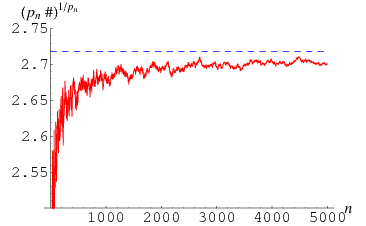


 تاريخ الرياضيات
تاريخ الرياضيات
 الرياضيات في الحضارات المختلفة
الرياضيات في الحضارات المختلفة 
 الرياضيات المتقطعة
الرياضيات المتقطعة
 الجبر
الجبر
 الهندسة
الهندسة 
 المعادلات التفاضلية و التكاملية
المعادلات التفاضلية و التكاملية 
 التحليل
التحليل
 علماء الرياضيات
علماء الرياضيات |
Read More
Date: 7-12-2020
Date: 19-10-2019
Date: 20-10-2020
|
Let  be the
be the  th prime, then the primorial (which is the analog of the usual factorial for prime numbers) is defined by
th prime, then the primorial (which is the analog of the usual factorial for prime numbers) is defined by
 |
(1) |
The values of  for
for  , 2, ..., are 2, 6, 30, 210, 2310, 30030, 510510, ... (OEIS A002110).
, 2, ..., are 2, 6, 30, 210, 2310, 30030, 510510, ... (OEIS A002110).
It is sometimes convenient to define the primorial  for values other than just the primes, in which case it is taken to be given by the product of all primes less than or equal to
for values other than just the primes, in which case it is taken to be given by the product of all primes less than or equal to  , i.e.,
, i.e.,
 |
(2) |
where  is the prime counting function. For
is the prime counting function. For  , 2, ..., the first few values of
, 2, ..., the first few values of  are 1, 2, 6, 6, 30, 30, 210, 210, 210, 210, 2310, ... (OEIS A034386).
are 1, 2, 6, 6, 30, 30, 210, 210, 210, 210, 2310, ... (OEIS A034386).

The logarithm of  is closely related to the Chebyshev function
is closely related to the Chebyshev function  , and a trivial rearrangement of the limit
, and a trivial rearrangement of the limit
 |
(3) |
gives
 |
(4) |
(Ruiz 1997; Finch 2003, p. 14; Pruitt), where e is the usual base of the natural logarithm.
REFERENCES:
Finch, S. R. Mathematical Constants. Cambridge, England: Cambridge University Press, 2003.
Pruitt, C. D. "A Theorem & Proof on the Density of Primes Utilizing Primorials." https://www.mathematical.com/mathprimorialproof.html.
Ruiz, S. M. "A Result on Prime Numbers." Math. Gaz. 81, 269, 1997.
Sloane, N. J. A. Sequence A002110/M1691 and A034386 in "The On-Line Encyclopedia of Integer Sequences."



|
|
|
|
التوتر والسرطان.. علماء يحذرون من "صلة خطيرة"
|
|
|
|
|
|
|
مرآة السيارة: مدى دقة عكسها للصورة الصحيحة
|
|
|
|
|
|
|
نحو شراكة وطنية متكاملة.. الأمين العام للعتبة الحسينية يبحث مع وكيل وزارة الخارجية آفاق التعاون المؤسسي
|
|
|